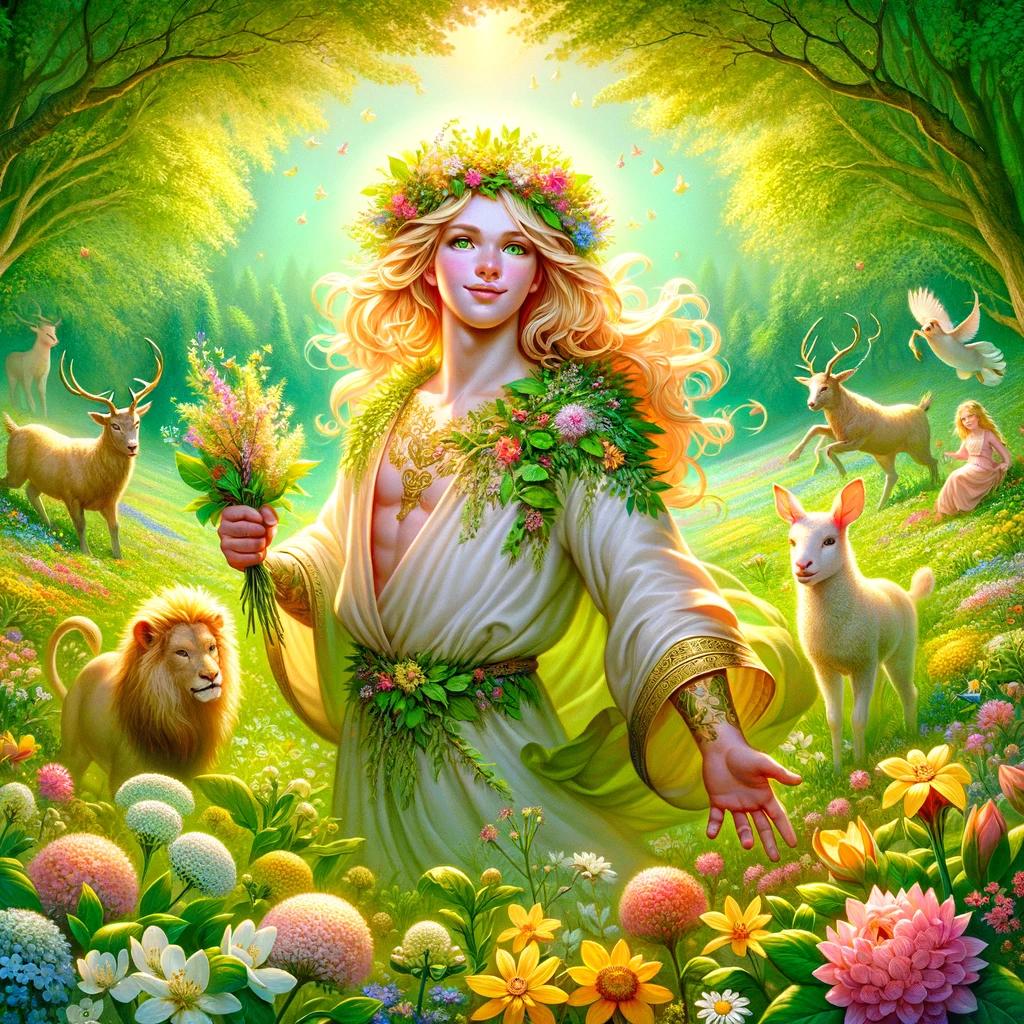Bereginya Goddess: Exploring the Ancient Slavic Deity of Nature and Protection

The Bereginya goddess holds a significant place in Slavic mythology, revered for her ability to shape-shift and her role as a protector of nature and home. Associated with water, trees, and vegetation, Bereginya embodies the essence of natural life and fertility.
Over time, interpretations of Bereginya have evolved, combining elements of the ‘Mother of the Home’ and the rusalka, a female water spirit. In modern times, she continues to be commemorated in Slavic communities, with monuments and special celebrations dedicated to her.
Explore the origins, symbolism, and cultural importance of the Bereginya goddess in this article.
The Origins of Bereginya Goddess in Slavic Mythology
The ancient Slavs held deep beliefs and reverence for their mythological heritage. Within this rich tapestry of folklore and storytelling, the figure of Bereginya emerged as a prominent goddess. She embodied the mystical connection between humanity and the natural world, serving as a guardian and protector of the land.
The Ancient Slavs and Their Beliefs
The ancient Slavs, a diverse group of tribes inhabiting Eastern Europe, possessed a deep spiritual connection with nature. They perceived the world around them as infused with divine spirits and deities who governed various aspects of life.
For the Slavs, nature was not merely a backdrop but a living entity deserving respect and veneration. They believed in a pantheon of gods and goddesses, each responsible for different facets of existence.
Amidst this celestial hierarchy, the Bereginya goddess occupied a significant position.
Mythological Significance of Bereginya Goddess
Bereginya held tremendous mythological significance within the Slavic belief system. As a shape-shifting deity, she possessed the power to transform into other Slavic goddesses or even assume a human form, often appearing as a woman.
Ethnographic records describe Bereginya as intricately associated with water, trees, and vegetation. She was viewed as a protector of natural life and served as a guardian of sacred spaces, ensuring the well-being and balance of the natural world.
Variations of Bereginya’s Name and Forms
Throughout the vast Slavic territories, Bereginya’s name and appearances varied. In different versions of the mythological narrative, she was known by alternative names such as Lada, Leyla, Dana, and Zhiva.
Bereginya’s embodiments encompassed extraordinary qualities as a woman or an ambiguous nature spirit, indistinguishable in form and appearance.
The name Bereginya derived from the word ‘pregynya,’ meaning a hill in the forest and closely connected to protection. She was believed to safeguard individuals, crops, and overall prosperity.
- Associated with water, trees, and vegetation.
- Protector of natural life and balance.
- Variations in names and diverse forms.
Bereginya Goddess: Protector of Nature and Home
The Bereginya goddess holds a significant role in Slavic mythology as a guardian and protector of nature and the home.
She is closely associated with the elements of water, trees, and vegetation, symbolizing the interconnectedness between humans and the natural world.
Association with Water, Trees, and Vegetation
Within Slavic mythology, Bereginya is deeply connected to the worship of water, trees, and vegetation. She embodies the life-giving forces present in these natural elements, representing their vitality and importance to the Slavic people.
It is believed that she oversees the well-being of rivers, forests, and plant life, ensuring their continued vitality and abundance.
Role in Protecting Natural Life and Fertility
Bereginya is believed to play a significant role in safeguarding natural life and fertility. She is revered as a nurturer and guardian of the environment, ensuring a balance between human activities and the well-being of flora and fauna.
From protecting wildlife to ensuring bountiful harvests, her presence is associated with the prosperity and abundance of natural resources in Slavic mythology.
Connection with the Cult of Motherhood and Maternal Elements
The cult of motherhood and maternal elements hold great significance in the worship of Bereginya.
She is regarded as a motherly figure, embodying the feminine qualities of protection, care, and guidance. Her association with fertility and nurturing extends not only to the natural world but also to human beings, providing assistance and support to those who uphold principles of truth and honor.
Folklore and Transformations of Bereginya
The folklore surrounding Bereginya has evolved over time, accompanied by various interpretations and transformations. These changes have shaped her modern identity, blending the concept of the ‘Mother of the Home’ with the rusalka, a water spirit entity.
Evolution of Beliefs and Interpretations
Throughout centuries, the beliefs and interpretations of Bereginya have undergone significant evolution within Slavic mythology. Stories and narratives have been passed down through generations, adapting and reshaping her character in response to cultural shifts and influences.
These changes reflect the dynamic nature of folk beliefs and the importance of mythology within Slavic culture.
Bereginya as a Combination of the ‘Mother of the Home’ and Rusalka
One notable transformation of Bereginya’s character involves the merging of characteristics from the ‘Mother of the Home’ archetype and the rusalka, a water spirit commonly associated with rivers and lakes. This fusion symbolizes both the protective maternal aspect and the enchanting allure of the natural world, emphasizing Bereginya’s multifaceted role in Slavic folklore.
Influence of Etymology on Bereginya’s Modern Identity
The modern understanding of Bereginya has been influenced by etymology and linguistic connections. The term ‘Bereginya’ is derived from the Ukrainian word ‘bereg,’ meaning ‘riverbank.’ This linguistic association further bolsters the perception of Bereginya as a guardian of nature, particularly water sources such as rivers and lakes.
The etymology plays a significant role in shaping the modern identity and interpretation of this revered deity.
Bereginya in Contemporary Culture and Commemorations
Cultural Importance of Bereginya in Slavic Communities
Bereginya holds significant cultural importance in Slavic communities, where she is revered as a powerful deity symbolizing protection, fertility, and the essence of nature. Her influence extends beyond ancient mythology, as she continues to be an integral part of Slavic traditions and folklore.
Berehynia Monument in Kiev: Symbolizing Protection and Guardianship
In the city of Kiev, Ukraine, a prominent monument stands in honor of Berehynia, a variation of Bereginya’s name. This monument serves as a symbol of protection and guardianship, reminding the community of the goddess’s role in safeguarding homes, nature, and the well-being of its people.
Continued Celebration of Bereginya on Special Occasions
Slavic communities still celebrate and honor Bereginya on special occasions. One such occasion is the annual gathering on July 15th, where people come together to pay tribute to the goddess and acknowledge her influence on fertility, the protection of homes, and the preservation of natural life.
As we observe the rich cultural heritage of the Slavic people, the commemoration of Bereginya reflects a deep connection with the natural world and an appreciation for the divine feminine energy that nurtures and protects all aspects of life.
FAQs about Bereginya Goddess and Slavic Mythology
What significance does Bereginya hold in Slavic mythology?
Bereginya is a highly significant figure in Slavic mythology, revered as a fundamental deity by the ancient Slavs. She embodies the nurturing power of nature and is associated with the protection of natural life and the preservation of the natural world.
As a shape-shifting goddess, Bereginya holds the ability to transform into other Slavic goddesses or even take on a human form. Her role as a protector and her associations with water, trees, and vegetation make her a revered deity representing the essence of the natural world.
How is Bereginya associated with the protection of homes and nature?
Bereginya is closely associated with the protection of homes and nature in Slavic mythology. She is believed to safeguard homes and ward off enemies and malevolent forces, acting as a patron spirit for honest individuals who live by principles of truth and honor.
With her connections to water, trees, and vegetation, she is also seen as a guardian of the natural environment, ensuring the well-being of plants, animals, and the overall balance of nature.
Bereginya’s role as a protector extends beyond human dwellings to the preservation and harmony of the natural world.
What is the connection between Bereginya and the cult of fertility?
Bereginya’s association with the cult of fertility stems from her role in promoting the well-being and abundance of life. She is seen as a bringer of new life and is believed to assist those who uphold truth and honor in their pursuit of fertility and growth.
The reverence for Bereginya as a guardian of nature and her associations with water, trees, and vegetation contribute to her role in fertility rituals and celebrations. By invoking her blessings, ancient Slavs hoped to ensure the prosperity and fertility of their crops, animals, and families.
Has Bereginya undergone any transformations over time?
Over time, the figure of Bereginya has experienced transformations and reinterpretations within Slavic mythology. Her image and importance have evolved, especially after Ukraine gained independence in 1991. Bereginya has undergone a folklore metamorphosis, now being identified as a combination of the ‘Mother of the Home,’ associated with the protection of the nation, and the rusalka, the water spirit.
This reinterpretation is influenced by popular etymology linking Bereginya’s name to the Ukrainian word ‘bereg,’ meaning ‘riverbank,’ and the related verb ‘berehty,’ meaning ‘to protect.’
How is Bereginya celebrated and honored in modern times?
In modern times, the reverence for Bereginya continues among Slavic communities.
Special celebrations and rituals are held in her honor, often on the 15th of July, in religious Slavic communities. Furthermore, her presence is commemorated through monuments dedicated to her, such as the Berehynia Monument in Kiev, Ukraine.
This monument symbolizes Berehynia as a guardian and protector of the city and reflects the cultural importance placed upon the deity. Through these celebrations and monuments, Bereginya’s role as a significant deity in Slavic mythology remains alive and continues to be appreciated in contemporary times.



















